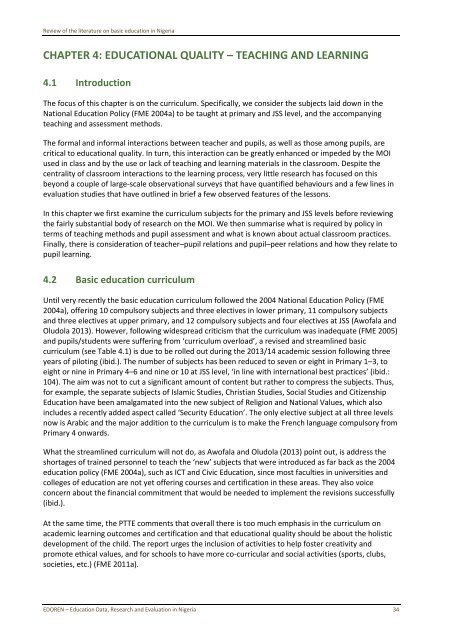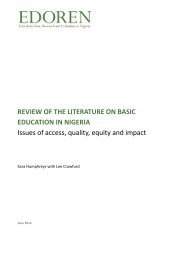review-of-the-literature-on-basic-education-in-nigeria-june-2014-3-1
review-of-the-literature-on-basic-education-in-nigeria-june-2014-3-1
review-of-the-literature-on-basic-education-in-nigeria-june-2014-3-1
You also want an ePaper? Increase the reach of your titles
YUMPU automatically turns print PDFs into web optimized ePapers that Google loves.
Review <str<strong>on</strong>g>of</str<strong>on</strong>g> <str<strong>on</strong>g>the</str<strong>on</strong>g> <str<strong>on</strong>g>literature</str<strong>on</strong>g> <strong>on</strong> <strong>basic</strong> educati<strong>on</strong> <strong>in</strong> NigeriaCHAPTER 4: EDUCATIONAL QUALITY – TEACHING AND LEARNING4.1 Introducti<strong>on</strong>The focus <str<strong>on</strong>g>of</str<strong>on</strong>g> this chapter is <strong>on</strong> <str<strong>on</strong>g>the</str<strong>on</strong>g> curriculum. Specifically, we c<strong>on</strong>sider <str<strong>on</strong>g>the</str<strong>on</strong>g> subjects laid down <strong>in</strong> <str<strong>on</strong>g>the</str<strong>on</strong>g>Nati<strong>on</strong>al Educati<strong>on</strong> Policy (FME 2004a) to be taught at primary and JSS level, and <str<strong>on</strong>g>the</str<strong>on</strong>g> accompany<strong>in</strong>gteach<strong>in</strong>g and assessment methods.The formal and <strong>in</strong>formal <strong>in</strong>teracti<strong>on</strong>s between teacher and pupils, as well as those am<strong>on</strong>g pupils, arecritical to educati<strong>on</strong>al quality. In turn, this <strong>in</strong>teracti<strong>on</strong> can be greatly enhanced or impeded by <str<strong>on</strong>g>the</str<strong>on</strong>g> MOIused <strong>in</strong> class and by <str<strong>on</strong>g>the</str<strong>on</strong>g> use or lack <str<strong>on</strong>g>of</str<strong>on</strong>g> teach<strong>in</strong>g and learn<strong>in</strong>g materials <strong>in</strong> <str<strong>on</strong>g>the</str<strong>on</strong>g> classroom. Despite <str<strong>on</strong>g>the</str<strong>on</strong>g>centrality <str<strong>on</strong>g>of</str<strong>on</strong>g> classroom <strong>in</strong>teracti<strong>on</strong>s to <str<strong>on</strong>g>the</str<strong>on</strong>g> learn<strong>in</strong>g process, very little research has focused <strong>on</strong> thisbey<strong>on</strong>d a couple <str<strong>on</strong>g>of</str<strong>on</strong>g> large-scale observati<strong>on</strong>al surveys that have quantified behaviours and a few l<strong>in</strong>es <strong>in</strong>evaluati<strong>on</strong> studies that have outl<strong>in</strong>ed <strong>in</strong> brief a few observed features <str<strong>on</strong>g>of</str<strong>on</strong>g> <str<strong>on</strong>g>the</str<strong>on</strong>g> less<strong>on</strong>s.In this chapter we first exam<strong>in</strong>e <str<strong>on</strong>g>the</str<strong>on</strong>g> curriculum subjects for <str<strong>on</strong>g>the</str<strong>on</strong>g> primary and JSS levels before <str<strong>on</strong>g>review</str<strong>on</strong>g><strong>in</strong>g<str<strong>on</strong>g>the</str<strong>on</strong>g> fairly substantial body <str<strong>on</strong>g>of</str<strong>on</strong>g> research <strong>on</strong> <str<strong>on</strong>g>the</str<strong>on</strong>g> MOI. We <str<strong>on</strong>g>the</str<strong>on</strong>g>n summarise what is required by policy <strong>in</strong>terms <str<strong>on</strong>g>of</str<strong>on</strong>g> teach<strong>in</strong>g methods and pupil assessment and what is known about actual classroom practices.F<strong>in</strong>ally, <str<strong>on</strong>g>the</str<strong>on</strong>g>re is c<strong>on</strong>siderati<strong>on</strong> <str<strong>on</strong>g>of</str<strong>on</strong>g> teacher–pupil relati<strong>on</strong>s and pupil–peer relati<strong>on</strong>s and how <str<strong>on</strong>g>the</str<strong>on</strong>g>y relate topupil learn<strong>in</strong>g.4.2 Basic educati<strong>on</strong> curriculumUntil very recently <str<strong>on</strong>g>the</str<strong>on</strong>g> <strong>basic</strong> educati<strong>on</strong> curriculum followed <str<strong>on</strong>g>the</str<strong>on</strong>g> 2004 Nati<strong>on</strong>al Educati<strong>on</strong> Policy (FME2004a), <str<strong>on</strong>g>of</str<strong>on</strong>g>fer<strong>in</strong>g 10 compulsory subjects and three electives <strong>in</strong> lower primary, 11 compulsory subjectsand three electives at upper primary, and 12 compulsory subjects and four electives at JSS (Aw<str<strong>on</strong>g>of</str<strong>on</strong>g>ala andOludola 2013). However, follow<strong>in</strong>g widespread criticism that <str<strong>on</strong>g>the</str<strong>on</strong>g> curriculum was <strong>in</strong>adequate (FME 2005)and pupils/students were suffer<strong>in</strong>g from ‘curriculum overload’, a revised and streaml<strong>in</strong>ed <strong>basic</strong>curriculum (see Table 4.1) is due to be rolled out dur<strong>in</strong>g <str<strong>on</strong>g>the</str<strong>on</strong>g> 2013/14 academic sessi<strong>on</strong> follow<strong>in</strong>g threeyears <str<strong>on</strong>g>of</str<strong>on</strong>g> pilot<strong>in</strong>g (ibid.). The number <str<strong>on</strong>g>of</str<strong>on</strong>g> subjects has been reduced to seven or eight <strong>in</strong> Primary 1–3, toeight or n<strong>in</strong>e <strong>in</strong> Primary 4–6 and n<strong>in</strong>e or 10 at JSS level, ‘<strong>in</strong> l<strong>in</strong>e with <strong>in</strong>ternati<strong>on</strong>al best practices’ (ibid.:104). The aim was not to cut a significant amount <str<strong>on</strong>g>of</str<strong>on</strong>g> c<strong>on</strong>tent but ra<str<strong>on</strong>g>the</str<strong>on</strong>g>r to compress <str<strong>on</strong>g>the</str<strong>on</strong>g> subjects. Thus,for example, <str<strong>on</strong>g>the</str<strong>on</strong>g> separate subjects <str<strong>on</strong>g>of</str<strong>on</strong>g> Islamic Studies, Christian Studies, Social Studies and CitizenshipEducati<strong>on</strong> have been amalgamated <strong>in</strong>to <str<strong>on</strong>g>the</str<strong>on</strong>g> new subject <str<strong>on</strong>g>of</str<strong>on</strong>g> Religi<strong>on</strong> and Nati<strong>on</strong>al Values, which also<strong>in</strong>cludes a recently added aspect called ‘Security Educati<strong>on</strong>’. The <strong>on</strong>ly elective subject at all three levelsnow is Arabic and <str<strong>on</strong>g>the</str<strong>on</strong>g> major additi<strong>on</strong> to <str<strong>on</strong>g>the</str<strong>on</strong>g> curriculum is to make <str<strong>on</strong>g>the</str<strong>on</strong>g> French language compulsory fromPrimary 4 <strong>on</strong>wards.What <str<strong>on</strong>g>the</str<strong>on</strong>g> streaml<strong>in</strong>ed curriculum will not do, as Aw<str<strong>on</strong>g>of</str<strong>on</strong>g>ala and Oludola (2013) po<strong>in</strong>t out, is address <str<strong>on</strong>g>the</str<strong>on</strong>g>shortages <str<strong>on</strong>g>of</str<strong>on</strong>g> tra<strong>in</strong>ed pers<strong>on</strong>nel to teach <str<strong>on</strong>g>the</str<strong>on</strong>g> ‘new’ subjects that were <strong>in</strong>troduced as far back as <str<strong>on</strong>g>the</str<strong>on</strong>g> 2004educati<strong>on</strong> policy (FME 2004a), such as ICT and Civic Educati<strong>on</strong>, s<strong>in</strong>ce most faculties <strong>in</strong> universities andcolleges <str<strong>on</strong>g>of</str<strong>on</strong>g> educati<strong>on</strong> are not yet <str<strong>on</strong>g>of</str<strong>on</strong>g>fer<strong>in</strong>g courses and certificati<strong>on</strong> <strong>in</strong> <str<strong>on</strong>g>the</str<strong>on</strong>g>se areas. They also voicec<strong>on</strong>cern about <str<strong>on</strong>g>the</str<strong>on</strong>g> f<strong>in</strong>ancial commitment that would be needed to implement <str<strong>on</strong>g>the</str<strong>on</strong>g> revisi<strong>on</strong>s successfully(ibid.).At <str<strong>on</strong>g>the</str<strong>on</strong>g> same time, <str<strong>on</strong>g>the</str<strong>on</strong>g> PTTE comments that overall <str<strong>on</strong>g>the</str<strong>on</strong>g>re is too much emphasis <strong>in</strong> <str<strong>on</strong>g>the</str<strong>on</strong>g> curriculum <strong>on</strong>academic learn<strong>in</strong>g outcomes and certificati<strong>on</strong> and that educati<strong>on</strong>al quality should be about <str<strong>on</strong>g>the</str<strong>on</strong>g> holisticdevelopment <str<strong>on</strong>g>of</str<strong>on</strong>g> <str<strong>on</strong>g>the</str<strong>on</strong>g> child. The report urges <str<strong>on</strong>g>the</str<strong>on</strong>g> <strong>in</strong>clusi<strong>on</strong> <str<strong>on</strong>g>of</str<strong>on</strong>g> activities to help foster creativity andpromote ethical values, and for schools to have more co-curricular and social activities (sports, clubs,societies, etc.) (FME 2011a).EDOREN – Educati<strong>on</strong> Data, Research and Evaluati<strong>on</strong> <strong>in</strong> Nigeria 34



